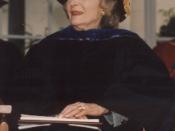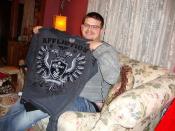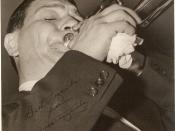Jazz Musicians Today's authors look for that limit in literature and written, that touch and magic that will not only impress the reader, but take him to another level of imagination. Some write fiction novels and some others travel far in the world to express something exciting and provoking. And others go into the lives of important characters in our history and society to write about them. This authors engaged in a labor of love in researching and writing about their character to convey information in form of a biography. Gene Lees's "Oscar Peterson: The will to swing"ÃÂ is the biography of a black Canadian jazz piano player named Oscar Peterson born in Montreal, Quebec in 1925. While Jay D.Smith & Len Guttridge's "Jack Teagarden: The story of a jazz maverick"ÃÂ is the biography of a white American jazz trombone player, Jack Teagarden, born in Vernon, Texas in 1905.
Both biographies and their authors show a comprehension of their character. Yet Gene Lees shows much more understanding and insight and gives more description towards Oscar Peterson's musical and personal life than Jay D.Smith & Len Guttridge towards the one of Jack Teagarden. Gene Lees's style and form includes a wide view with different perspectives of Peterson all in an objective point of view. While Jay D.Smith & Len Guttridge's style doesn't flow as smooth and is not as well organized.
Gene Lees's "Oscar Peterson: The will to swing"ÃÂ is 314 pages long divided into 21 chapters and Jay D.Smith & Len Guttridge's "Jack Teagarden: The story of a jazz maverick"ÃÂ is 184 pages divided into 11 chapters. As any given author knows, the introduction of a biography needs to be captivating, to leave the reader interested all along. Gene Lees's approach for the introduction was much more fascinating than Smith & Guttridge's. Lees throws at us some adrenaline by describing the craziness of a crowd after a live performance in Italy by Peterson.
" "ÃÂFan-tas-tico! Fan-tas-tico! Fan-tas-tico!' the crowd chanted the one word over and over, rhythmically, accelerando and molto cresecendo, like a growing great wave that smashes at least on rocks, and a roar of renewed clapping rose in the air."ÃÂ (Lees 1) Just in this first sentence of the biography, Lees is giving us a comparison and figures of speech and puts the reader in a environment of excitement, motivating for further reading. The introduction doesn't talk at all about the birth and young life of Peterson, instead Lees describes his personal relationship with him to make the reader realize how close they are as friends to assure secure and true facts about Peterson all through out the biography. In the other hand, Smith & Guttridge's introduction is effective yet simple. They start of from the story of Jack's parents in Vernon to his birth, to his years in high school and the death of his dad. The flow is decent and appropriate but compare to the one of Lees's the style seems old and too simple. No fingers are pointed at Smith & Guttridge since they wrote the biography in 1960 while Lees's was completed in 1999. The style of written became more advanced in that long period of time. Yet Lees's approach to inform the reader is much wider than the one of Smith & Guttridge.
Smith & Guttridge follow a typical structure of a biography. They gives us the facts and explain to us the life of Teagarden from young to old. Pictures and personal quotes are giving to help the reader understand the character.As well as quotes from friends, family, colleagues and associates of Teagerden. In this next simple example, the authors use quotes and describe the state of mind of Teagarden under a difficult situation, where he has to pay some taxes for his band. " Jack gripped the sides of his chair. "ÃÂWhat can I do ? I've nothing left than my horn. Shall I sell it ?' His voice rose and trembled. "ÃÂIs that what you want ?' Then the official sighed. "ÃÂI'm sorry, Mr. Teagarden. But the amount must be settled.' "ÃÂHow much is owning ?' "ÃÂFourteen thousand dollars.' The shock purged his mind"ÃÂ ( Smith & Guttridge 157). This example illustrates one of the few forms they use to convey information. Once again, its not bad, its just too simple compare to the level of Lees. Lees uses a much higher number of methods in the biography to convey the information in a more efficient way, which gives the reader a more secure source of the character, in this case, Peterson. Lees uses, besides pictures and quotes, radio interviews, one on one personal interviews, after live performance interviews, magazine articles, newspaper articles and memos. Through the biography, the reader will bump to this types of sources of information and each type of source, is dated, so the reader could see that it is a fact. Having said that, it has to be said that some sources are in the biography so that Lees can contradict them with his own words in experience with his long friendship with Peterson. Even sometimes, he puts a whole magazine or newspaper article about Peterson and adds in parenthesis the true only if a lie or a misunderstanding has been written. Lees is a journalist, a journalist against journalist. He completely disagrees with some comments on articles about Peterson, but yet he understood as a journalist, that the game works like that. Anytime he put an article on the biography, the date, the name of the magazine and the magazine issue will be as well in there. And anytime he put a radio interview, he gave the name of the show, the date, the broadcasting corporation and the name of the announcer which interview Peterson.
"The Merchant Navy show; July 11,1944;The Canadian Broadcasting Corporation; Announcer: Rusty Davis; Music starts, piano with bass and drums. [ The tune is ChinaBoy] Davis : Oscar, that was terrific ! Tell me, boy, how many hands you got ? Oscar: Just two, Mr.Davis, just two. But I like to make'em work hard Davis : You're not kidding. Tell me, Oscar, you're still going to school, aren't you ? Oscar (very wooden, obviously uncomfortable with the stereotype) : That's right. My folks would tan my hide if I missed a day..."ÃÂ (Lees 53). As you can see by this short portion of a radio interview, Lees want the reader to know everything that is going on in the settings. He wants to establish a relationship with the reader, a relationship based on facts that will lead to trust. That is what makes his biography much more descriptive than Smith & Guttridge's, by explaining every single thing he could find about Peterson and giving the reader the proper and exact information. Smith & Guttridge do this, just in a less efficient way as proven. They as well show a lower level of diction and vocabulary towards the playing items, in their case the trombone, than Lees towards the piano.
Jack Teagarden is one of the best trombone players in the history of jazz. In the biography, the techniques and methods he uses to play his trombone are not well organized and low in information, or not described at all. The reader must wonder how does Teagarden play the instrument and what makes him so great, here is where Smith & Guttridge fail in their biography, by not being as instructive as expected. They go around the instrument, but they don't dissect it. "Jack was breaking in a new trombone, a handsome small-bore horn with a six-inch bell"ÃÂ (Smith & Guttridge 26). After reading this quote, the reader is asking himself, what kind of a new trombone ? A small-bore horn ? What is a six-inch bell ? The answers to this questions are never answer, through out the biography Smith & Guttridge give us terms of the instruments and don't explain them. Is a big mistake, it leaves the reader wondering too much. While Lees dissects Peterson's instrument, the piano by explaining the keys patterns, the pedal movement and the different techniques that Peterson uses. "Each tune, began with a fast, straight-forward version of the melody, then, after a few bars, swung into Peterson's impromptu variations - interlaced arabesques, rhythmical counterpoints, stream-of-consciousness insertions from other tunes-then back to the original melody. Throughout, Pianist Peterson accompanied himself with his own scat-singing, in the pause mopped his sweating brow with his handkerchief. Throughout, for all his jet-propelled techniques, his fingers frisked the keys with the precision of a hell-bent Horowitz"ÃÂ (Lees 98). Like we can see, Lees's usual descriptions of Peterson playing are more advanced that the ones of Smith & Guttridge's for Teagarden. These descriptions will give the reader a better picture of Peterson, making the biography a better material.
Gene Lees is a lyricist, songwriter, journalist and editor of a jazz magazine, he is very known in the world of jazz and he is very close to many jazz artists. What makes his biography better has been discussed. He had that advantage of being close to Peterson, making him write a biography with more respect and love, with more sources, a better vocabulary and a more insight character analyze. Smith & Guttridge did a good job, but their biography is too small of quality to compete with authors such as Lees. They explore Jack Teagarden with affection, respect and detail. It is a wonderful biography. But, Lees demonstrate great knowledge in the world of jazz, like a commitment to the music, taking his biography to the next level of written. Both styles are good but it came to question which one is more efficient. And with out a second thought, Gene Lees stepped up for the prize.




